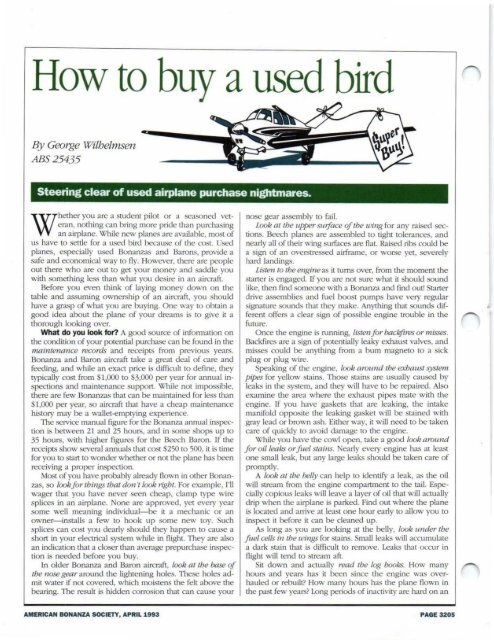April 1993 - American Bonanza Society
April 1993 - American Bonanza Society
April 1993 - American Bonanza Society
You also want an ePaper? Increase the reach of your titles
YUMPU automatically turns print PDFs into web optimized ePapers that Google loves.
How to buy a used bird<br />
By George Wilhelmsen<br />
ABS25435<br />
Steering clear of used airplane purchase nightmares.<br />
Whether YOLI are a student pilot or a seasoned velemn,<br />
nothing can bring more pride than purchaSing<br />
an airplane. \Vhile new planes are available, most of<br />
us have to settle for a used bird because of the cost. Used<br />
planes, especially used <strong>Bonanza</strong>s and Barons, provide a<br />
safe and economical way to fly. H owever, there are people<br />
out there who are out to get your money and saddle you<br />
with something less than what you desire in an aircraft.<br />
Before you even think of laying money down on the<br />
table and assuming ownership of an aircraft, you should<br />
have a gr-dSp of what you are buying. One way to obtain a<br />
good idea about the plane of your dreams is to give it a<br />
thorough looking over.<br />
What do you look for? A good source of information on<br />
the condition of your potential purchase can be found in the<br />
maintenance records and receipts from previous years.<br />
<strong>Bonanza</strong> and Baron aircraft take a greal deal of ca re and<br />
feeding, and while an exact price is difficult to define, they<br />
typically cost from 51,000 to $3,000 per year for annual inspectiOns<br />
and maintenance support. \Vhile not impossible,<br />
there are few <strong>Bonanza</strong>s that can be maintained for less than<br />
SI ,ooo per ye-dr, so aircraft that have a cheap maintenance<br />
histolY may be a wallet-emptying experience.<br />
The selvice manual figure for the <strong>Bonanza</strong> annual inspec~<br />
Lion is between 21 and 25 hours, and in some shops up to<br />
35 hours, with higher figures for the Beech Baron. If the<br />
receipts show several annuals that cost $250 to 500, it is time<br />
for you to start to wonder whether or nOt the plane has been<br />
receiving a proper inspeaion.<br />
Most of you have probably already flown in other <strong>Bonanza</strong>s,<br />
so lookfor things that don't look right. For example, I'll<br />
wager thal you have never seen cheap, clamp type wire<br />
splices in an airplane. None are approved, yet eve!), year<br />
some well meaning individual-be it a mechanic or an<br />
owner-installs a few to hook up some new toy. Such<br />
splices can cost you dearly should they happen to cause a<br />
short in your electrical system while in flight. TIley are also<br />
an indication that a closer than average prepurchase inspection<br />
is needed before you buy.<br />
In older <strong>Bonanza</strong> and Baron aircmft, look at the base of<br />
the nose gear around tile lightening holes. These holes admit<br />
water if nOt covered, which moistens the felt above the<br />
bearing. The result is hidden corrosion that can cause your<br />
nose gear assembly to fail.<br />
Look at the upper sUljace of the wing for any raised sections.<br />
Beech planes are assembled to tight tolemnces, and<br />
nearly all of their wing surfaces are flat. Raised ribs could be<br />
a sign of an overstressed aiIframe, or worse yet, severely<br />
hard landings.<br />
Listen. to the engine as it turns over, from the moment the<br />
starter is engaged. If you are not sure what it should sound<br />
like, d1en find someone with a <strong>Bonanza</strong> and find out! Starter<br />
drive assemblies and fuel boost pumps have very regular<br />
signature sounds that tiley make. Anything that sounds different<br />
offers a clear sign of possible engine trouble in the<br />
future.<br />
Once the engine is running, listen for backfires or misses.<br />
Backfires are a sign of potentially leaky exhaust valves, and<br />
misses could be anything from a bum magneto to a sick<br />
plug or plug wire.<br />
Speaking of the engine, look around the exhaust system<br />
pipes for yellow stains. Those stains are usually caused by<br />
leaks in the system, and they will have to be repaired. Also<br />
examine the area where the exhaust pipes mate with [he<br />
engine. If you have gaskets that are leaking, the intake<br />
manifold opposite the leaking gasket will be stained with<br />
gr-.ay lead or brown ash. Either way, it will need to be taken<br />
care of quickly to avoid damage to the engine.<br />
While you have the cowl open, take a good look tlround<br />
for oil leaks or fuel stains. Nearly every engine has at least<br />
one smallle'dk, but any large leaks should be taken care of<br />
promptly.<br />
A look at the belly can help to identify a leak, as the oil<br />
will stream from the engine compartment to the tail. Espe<br />
Cially copious leaks will leave a layer of oil that will actually<br />
drip when ule 'Iirplane is parked. Find out where the plane<br />
is located and arrive at least one hour early to allow you to<br />
inspect it before it can be cleaned up.<br />
As long as you are looking at the belly, look Itl1der the<br />
fuel cells in the wings for stains. Small leaks will accumulate<br />
a dark stain that is difficult to remove. Leaks that occur in<br />
flight will tend to stre-dm aft.<br />
Sit down and acnlally read the log books. How many<br />
hours and years has it been since the engine was overhauled<br />
or rebuilt? How many hOllrs has the plane flown in<br />
the past few years? Long peliods of inactivity are hard on an<br />
•<br />
AMERICAN BONANZA SOCIETY, APRIL <strong>1993</strong><br />
PAGE 3205

















